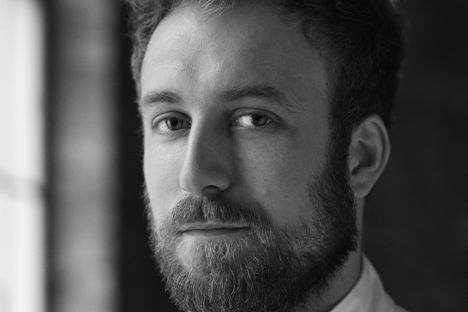
Ones to watch: Rob Roy Cameron
Botswana-born Rob Roy Cameron spent years under the wing of Albert Adria in Spain before bringing his hyper-detailed molecular gastronomy to the UK. Pete Dreyer caught up with the chef at his new restaurant – Gazelle.
Ones to watch: Rob Roy Cameron
Botswana-born Rob Roy Cameron spent years under the wing of Albert Adria in Spain before bringing his hyper-detailed molecular gastronomy to the UK. Pete Dreyer caught up with the chef at his new restaurant – Gazelle.
View more from this series:
Ones to watchThere’s no one correct way to become a top chef. Some people know from an early age that they want to cook for a living, and at fourteen years old they’re there in the pot wash with their arms deep in a sink full of hot water. Some chefs study food at college, whilst others jump straight into restaurants and make the kitchen their classroom. There are those who take the road less travelled, coming from another career to follow their passion. We’ve spoken to a lot of chefs, and heard many of these stories, but it’s fair to say – no-one has travelled quite the road that Rob Roy Cameron has taken into the kitchen.
Born in Botswana, Rob never really entertained the idea of becoming a chef, but he loved cooking, and certainly loved eating. ‘My neighbour had a metal works company,’ he says, ‘and when they stopped for lunch, they would just make a fire and start cooking. I was four or five years old, so I’d just go over there and eat their food. My mum always used to get pissed off, because I’d go home and she was like, ‘you’ve eaten, haven’t you?’ and I’d have grease all over my face.’
By the age of six, Rob was baking pastries in his mum’s oven at home and selling them to his neighbours. He’d go out foraging in the day and then cook whatever he could for fun (if he was allowed in the kitchen). ‘I always liked it,’ he says, ‘but my mum always said, ‘don’t become a chef, because you’ll work a lot of hours and you won’t earn a lot of money’.’ Rob’s mum – herself the owner of a pizza restaurant – knew all too well the stresses of cooking for a living, but it never mattered to Rob. ‘If you’re working, you’re not spending the money anyway,’ he grins. ‘So it works out.’
Rob moved to South Africa in his teens, then flew to London at seventeen to pursue a career in photography. ‘I wanted to do more architectural photography, but it didn’t really work out that way,’ he explains. ‘I had this crazy agent and I was having to do a lot of fashion work – the whole scene was just a bit too much.’ Dissuaded from his dreams, he went travelling and ended up in Spain with a friend. Broke and in need of funds to get back to the UK, he took a job in a hotel kitchen as a prep chef. ‘I stayed for about a year in the end,’ he says. ‘The chef didn't speak English and I couldn't speak any Spanish, so it was quite an easy job! I didn't have to talk a lot, and they were quite patient with me.’
Rob eventually returned to the UK armed with a solid grounding in basic cooking technique and a ‘slightly elaborated CV’, and landed a job with Michael Caines at Abode, before moving to the fine dining side of things at Roux at the Landau. By chance, a Spanish colleague needed help with his own restaurant back home, and before he knew it, Rob found himself in Spain again. ‘The plan was to go from there to a stage at El Celler de Can Roca, but I needed money,’ says Rob. He took a job as head pastry chef at Rodero, a small Michelin-starred restaurant in Pamplona which coincidentally happened to be a favourite haunt of Albert Adrià. ‘Albert used to work at Rodero,’ Rob explains, ‘and he came back to do a demonstration, so I helped him with that. We kept talking and working on small events together, and then he asked me to move to Barcelona to work at elBulli.’
At the time, elBulli had an almost mythical reputation among chefs and gastronomes alike. It was the home of molecular gastronomy – a place where you could experience a brief glimpse of the future, and what food might be like in fifty years' time. It was also the start of a new chapter for Rob, who became Albert’s right hand man. After his stint at elBulli, Rob helped Albert open Tickets and 41 Degrees in Barcelona, both of which had waiting lists to rival that of the legendary elBulli. It was quite an achievement for a chef still in his early twenties – handpicked to work alongside one of the best chefs in the world – but like much of what he’s achieved in his career, Rob plays it down with softly spoken humility. Though working with Albert was a baptism by fire, Rob admits that he learnt a huge amount in his six years alongside the younger Adrià brother. ‘He’s a lot more relaxed now,’ says Rob of his old mentor, ‘but in the beginning, he was really intense. He’s all over the place during service, so it wasn’t always fun! He’s more of a thinker than a practical chef, but he taught me a lot.’
After six years working with Albert, Rob started to feel the strain of the business. The last two years in Barcelona – spent opening and then running 41 Degrees in the neighbourhood of Sant Antoni – had been particularly taxing, and a change of scenery was desperately needed. Rob headed home to take a break from the industry, but rather than jumping on a plane, he rode all the way from Barcelona to South Africa on the back of his 1988 Honda motorcycle. ‘It’s almost as old as me,’ he grins. ‘Before I started photography I worked as a mechanic – I was building bikes and fixing trucks, so I just fixed it up for the trip.’
I’ve come to realise by this point that Rob’s modesty means he often skips over huge details. When he says he ‘just fixed it up’, what he means is that he repaired and serviced his own vintage motorcycle for over eight thousand miles through Africa, all in the midst of the Arab Spring. ‘I was in Libya when they killed the American ambassador,’ he adds, with an air of nonchalance. ‘They wouldn’t let me into the country from Tunisia, they said I was going to get shot as soon as I crossed the border, but it was fine.’
Having safely negotiated the Arab Spring and various uprisings across North Africa, Rob returned to the UK. London had changed an awful lot in the decade he’d been away, and Rob’s education with the Adriàs made him hot property in London’s evolving culinary scene. Shortly after, he teamed up with world famous mixologist Tony Conigliaro to open Untitled in Dalston, which impressed many a reviewer with inventive Japanese-inspired snacks, before the pair embarked on a second project – Gazelle in Mayfair’s Albemarle Street.
The menu at Gazelle flexes many of Rob’s old Adrià muscles, displaying some serious technical flair as well as dizzying, innovative flavour combinations. There’s frozen yeast as a snack, alongside intriguing dishes like cucumber, coconut and Oscietra caviar; halibut, orange and elderflower and pig’s tails with Jerusalem artichokes and Manhattan. ‘The menu is designed to be fluid,’ says Rob. ‘We’re going for interesting flavours and textures – because each dish is two or three bites, we can be a bit more weird with the combinations.’ The desserts are equally fascinating – Rob displaying his fantastic pastry technique with combinations like grape, bee pollen and yoghurt; goat’s cheese, peanut and soy and carrot, hibiscus, thyme and rose. ‘A lot of the time, restaurants just don’t put as much effort into the desserts,’ he says. ‘I wouldn’t say our desserts are overly complicated, but they’re definitely interesting!’
There’s no doubt that Gazelle is still finding its feet. The menu is still expanding as Rob and his team settle into the kitchen, and he says that the combinations will get more inventive as time goes on. I ask whether awards are in the back of his mind, particularly given his old mentor’s history with such things. He grins. ‘A little bit,’ he admits. ‘The last time I saw Albert was at The World’s 50 Best [restaurant awards] and the first thing he said to me was, ‘oh, where’s your restaurant? What number’s your restaurant?’ I’d love to be at that level again, but if you’re just chasing that all the time, I don’t think you’ll enjoy what you’re doing right now. I learnt that working with him – every restaurant we opened, it was like we had to get a star in the next year.
‘Our first job is to get everything running smoothly,’ he says in closing. ‘We’re really focused on making sure the work environment is right for all our chefs, and that we have the right suppliers that deliver us quality. Once we relax and we’re all happy with what we’re doing, everything else will come.’


